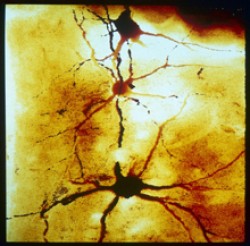Device Restores Movement to Paralyzed Limbs
Device Restores Movement to Paralyzed Limbs
Monkeys temporarily paralyzed from the elbow down to their fingers were able to grasp and release a ball with the help of electrodes in the brain that directly stimulate the hand muscles. This type of technology may one day help paralysis victims regain muscle control.

Motor neurons. Image by Dr. David Becker, Wellcome Images. All rights reserved by Wellcome Images.
The spinal cord is the main information pathway between the brain and the rest of the body. Injury to the spinal cord often leads to paralysis. About a quarter of a million Americans today are living with spinal cord injuries. Researchers have made some progress in repairing broken connections between the brain and muscles. An alternative approach has been to use brain cell activity to bypass the broken connections and directly control muscles.
In an effort to restore movement to paralyzed limbs, a team led by Dr. Lee E. Miller at Northwestern University in Chicago set out to create a neuroprosthesis—a device that replaces lost or impaired nervous system function. Their work, which was partially funded by NIH’s National Institute of Neurological Disorders and Stroke (NINDS), appeared in the early online edition of Nature on April 18, 2012.
The scientists studied 2 monkeys that were trained to pick up rubber balls and drop them into a tube. After training, each monkey had a multi-electrode recording array implanted in the area of the brain that controls the hands. This brain-computer interface allowed the scientists to track the activity of about 100 brain cells as the monkeys performed the task. The investigators were also able to decipher the signals that generate arm and hand movements.
The researchers then used the signals from the implanted interface to control a stimulation device that delivers electrical current to muscles and causes them to contract. This system bypasses the spinal cord and allows the brain to directly control muscle movement.
To test the device, the researchers gave the monkeys a local anesthetic, which blocked nerve activity at the elbow and caused temporary paralysis of the hand. With the aid of the neuroprosthesis, both monkeys regained movement in the paralyzed hand. They could pick up and move the ball and complete the task as before. The team found that their system also restored the ability to adjust grip strength, which is necessary to perform everyday tasks.
“With these neural engineering methods, we can take some of the important basic physiology that we know about the brain and use it to connect the brain directly to muscles,” Miller says. “This connection from brain to muscles might someday be used to help patients paralyzed due to spinal cord injury perform activities of daily living and achieve greater independence.”
While the temporary nerve block used by the team is a useful model of paralysis, Miller cautioned that it doesn’t replicate all the changes seen after brain and spinal cord injuries. The next steps will include testing this system in primate models of long-term paralysis and studying how the brain changes as it continues to use this neuroprosthesis.
###
* The above story is reprinted from materials provided by National Institutes of Health (NIH)
** The National Institutes of Health (NIH) , a part of the U.S. Department of Health and Human Services, is the nation’s medical research agency—making important discoveries that improve health and save lives. The National Institutes of Health is made up of 27 different components called Institutes and Centers. Each has its own specific research agenda. All but three of these components receive their funding directly from Congress, and administrate their own budgets.




















